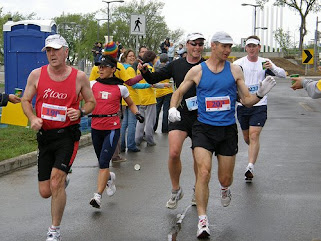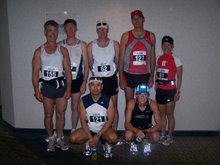The following article was featured on the Sudbury Rocks website
Fixing the FadeHow to feel strong in the final miles of your next marathon
By Greg McMillan, M.S.
As featured in the September 2007 issue of Running Times Magazine
Like most first-time marathoners, I sailed through 18 miles of my first marathon feeling like a million bucks. By 21 miles I wasn’t worth five cents. I faded badly over those final six miles. My second marathon was even worse. Run in hot and humid conditions, I was reduced to the marathoner’s survival shuffle even earlier.
By my third marathon, I figured a few things out and voila! — no fade. I finally felt like I actually raced the full marathon distance and set a 10-minute personal best. Here are the three things that I find help fix that marathon fade.
Fix #1: Decrease Your Delta
When I first evaluate a runner’s marathon training, I calculate what I call the “long run delta.” The “long run delta” is the difference between your longest long run in your marathon phase and your average long run in the six weeks prior to beginning your 12-week marathon-specific training. For example, if your average long run prior to marathon training is 14 miles and your longest long run during your marathon plan is 22 miles, then your long run delta is eight miles (22 - 14 = 8). If you regularly run 12 miles and your longest run is 22 miles, then your long run delta is 10 miles.
I’ve found that if runners simply decrease their long run delta (meaning that they increase their normal long run distance prior to marathon training), they are less likely to fade in the final few miles of their marathon. I’ve also found that a long run delta of six or less miles works best for runners hoping to qualify for Boston.
Clever runners, of course, suggest that it’s easy to get a long run delta of six or less. All you have to do is do pre-marathon long runs of 12 miles and marathon long runs of 18 miles. While this is a popular strategy for beginning marathoners, it isn’t the best plan if you’re trying to fix your marathon fade. You need to condition the leg muscles to withstand the stresses of running long. You want to improve your body’s ability to fuel these muscles for the long run. And, you want to callous the mind to running while tired. These are best accomplished by running more and longer long runs.
If you plan at least one 22-miler in your marathon plan, make sure that you are running a few 16 to 18 milers prior to starting your 12-week marathon training program. Increasing your pre-marathon long run length, combined with adequate marathon-phase long runs, is the best way to decrease your delta and fix your fade. There simply are no shortcuts to faster marathoning.
Fix #2: Add Four Fast Finish Long Runs to Your Plan
I learned about the fast finish long run from Gabriele Rosa, the coach of world-record holder Paul Tergat. In this type of long run, you start at your normal long run pace but run the last four to 10 miles at your goal marathon pace. If you want to run 3:30 for the marathon then run the last few miles at 3:30 pace. Want to run 2:30? Then, run the last few miles at 2:30 pace.
The idea is that you are training your body (and maybe more importantly, your mind) to run strong even when you are tired, just like you will need to do in the marathon. My experience is that runners who perform four fast finish long runs (one every other week) in their training are much less susceptible to the finishing fade.
Why four? I’ve learned that doing more than four fast finish long runs causes runners to peak too soon. Your best runs become the fast finish long runs and not the marathon. Less than four fast finish long runs can work, but more often I find that runners need more of this type of run to really dial in how to run them well.
I suggest that runners start with a 14- to 16-mile long run about eight weeks prior to your marathon, with only the last four miles at goal marathon pace. Two weeks later, extend the total length of the run as well as the marathon pace portion by one to two miles. By the fourth one, you end up with an 18- to 20-mile run with the last eight to 10 miles at goal marathon pace. There is no doubting that this is tough running but it really helps condition the body and mind to running marathon pace when tired, thus fixing the fade.
Fix #3: Add One or Two Super Long Runs
For most runners, decreasing the long run delta and adding fast finish long runs should take care of the fade (assuming proper pacing, and adequate fueling and hydrating before and during the race). If, however, you are still fading, I suggest one more fix: adding one to two super long runs.
A super long run is an easy long run lasting 24 to 28 miles. The goal of the run is to provide a very large stimulus for the body to adapt to the marathon distance. A slow pace is better than a fast pace, as you simply want to stay out there for a long, long time.
This type of workout is very stressful to the body and you must alter your regular training before and after it to recover. I never advise more than two super long runs in a marathon plan, spaced apart by four weeks; I like to schedule them eight weeks and four weeks before the marathon. Also, you must take three to five days of just easy jogging or cross-training after each super long run — don’t worry about skipping workouts or even the next weekend’s long run in favor of proper recovery. You have really challenged your endurance by running a long, long way and now must provide the body plenty of rest in order to reap the benefits.
Greg McMillan is an exercise physiologist and USATF certified coach who helps runners via his website www.mcmillanrunning.com
Copyright ©2007 Running Times Magazine. All rights reserved.
The Barrie RoadRunners
barrie.roadrunners@gmail.com
The Apparel blog can be found here
http://brrapparel.blogspot.com
Barrie RoadRunners Local Routes
Tuesday, November 27, 2007
Getting Past the Wall in a Marathon
Posted by
Barrie RoadRunners
at
2:48 p.m.
![]()
Subscribe to:
Post Comments (Atom)


























No comments:
Post a Comment